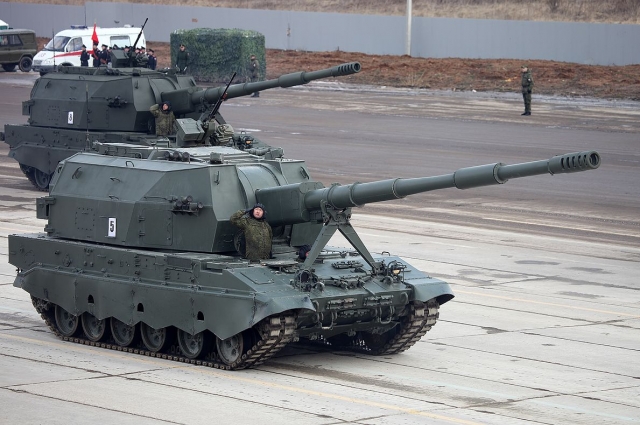The Ministry of Defense of the Russian Federation reports that state tests of the self-propelled howitzer “Coalition-SV” will begin in 2022. Their end is scheduled for September of the same year. During this time, a special commission will assess the reliability of the installation and how it meets the tactical and technical characteristics. If everything goes well, then the car will begin to enter the troops. АиФ.ги I found out what is known about the most modern Russian howitzer and for what tasks it is necessary for the Russian army.

Self-propelled howitzer Coalition-SV. Photo: Commons.wikimedia.org
Features
According to some experts, this is the most ambitious project for artillery troops in the last decade. The gun surpasses all existing domestic analogues.
This is a wheeled vehicle, and it has a number of advantages over tracked guns. In particular, it can move on general-purpose roads, and also has high mobility and high resource compared to tracked models.
Thanks to the most thoughtful automation, the howitzer can open fire at the touch of just one button. Ammunition is supplied by a specially designed robot, and calculations for maximum accuracy of the shot are performed by computer equipment on board.
According to experts who have studied all the available characteristics of the “Coalition-CB”, this self-propelled gun will help to increase the striking power of the Russian artillery several times. In addition, it significantly bypasses all such installations that are in service with NATO forces. Before that, no Russian artillery complex provided a firing range of 70 km.
Purpose
The ACS is designed to destroy important targets in the deep rear of the enemy – these are command posts, air defense and missile defense systems, field airfields, supply lines and rock roads. High mobility and rate of fire make it possible to effectively conduct counter-battery warfare while remaining invulnerable to enemy artillery.
What are ACS good for?
Self-propelled artillery units (self-propelled guns) were first used on the battlefields of the First World War, and were widely used during the Second World War. In modern conditions, the level of mobility is one of the key criteria that artillery must meet. An insufficiently mobile artillery installation can be destroyed in a matter of minutes by the enemy’s return fire.
With the improvement of weapons and detection means, the permissible time spent by a howitzer in one firing position was reduced to one minute. During this time, the gun must conduct high-intensity fire in order to quickly change its location. Accordingly, the higher the firepower of the gun, the shorter the time interval of its location at one point can be.
Development
Work on the creation of a new self-propelled howitzer “Coalition” began in the mid-2000s on the basis of the Central Research Institute “Burevestnik”. The new machine was supposed to surpass in its tactical and technical characteristics the already-in-service ACS “Msta-S”, as well as foreign models of guns of this class.
Already in 2006, one of the mock-up samples of the Coalition appeared, during the creation of which the achievements accumulated during the design of the self-propelled howitzer Msta-S were involved.
The new howitzer is significantly superior to the self-propelled gun “Msta-S” adopted in 1989. So, the firing range of the Coalition is from 50 to 70 km, while the Msta shoots at 25 to 29 km. At the same time, the “Coalition” carries 70 ammunition sets on board against 50 from the “Msta” and is capable of firing up to 23 rounds per minute, while the “Msta” can only do ten. “The coalition” can move along the highway surface at speeds up to 90 km/h, a crew of three people is needed to control the installation.
Adoption
On May 22, 2020, the Rostec State Corporation announced the delivery of the first batch of self-propelled howitzers to the Coalition-CB of the Russian Army.
In 2017, the Russian Defense Ministry signed a contract for the supply of an experimental batch of artillery systems “Coalition”. It was about buying ten cars. Serial deliveries of howitzers will start after the completion of all tests, which according to the plan should end in 2020. At the beginning of 2018, the Deputy Minister of Defense of Russia Yuri Borisov He said that the armed forces will receive 12 more 2C35 “Coalition-CB” installations, which will also be tested until the end of 2020.
https://iz.ru/1259811/aleksei-ramm-bogdan-stepovoi/udarnaia-ustanovka-v-rossii-nachinaiutsia-gosispytaniia-sau-koalitciia-sv?


